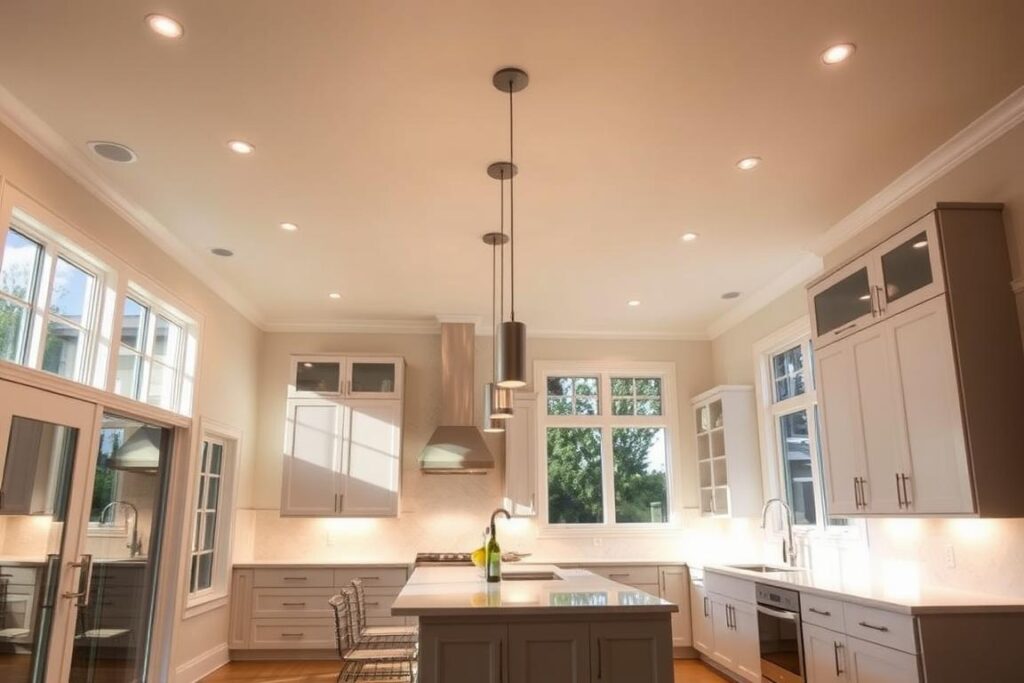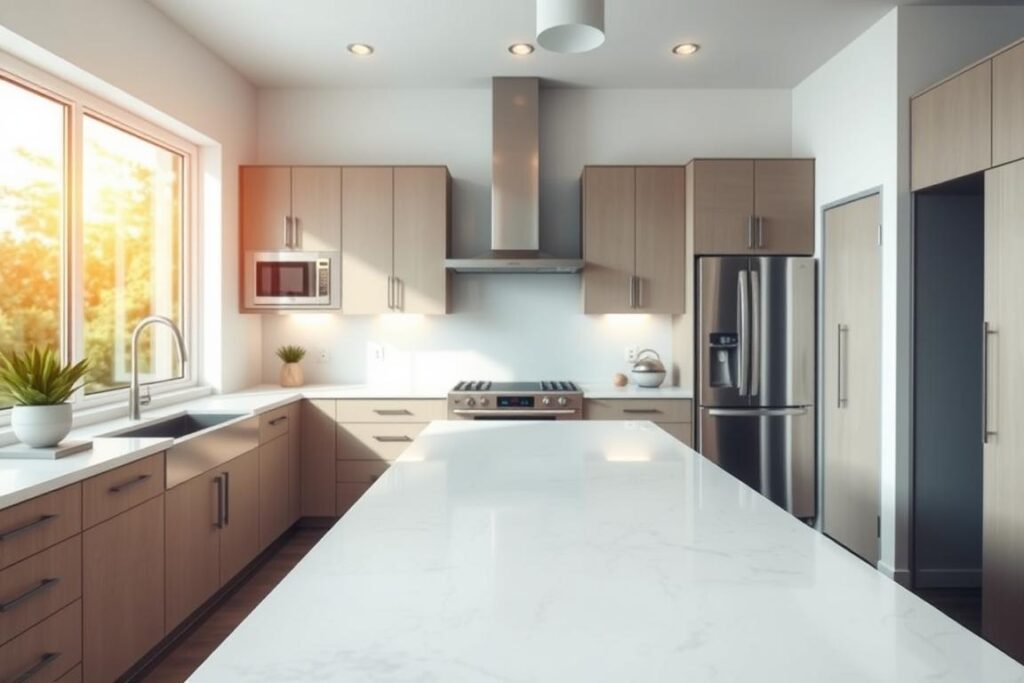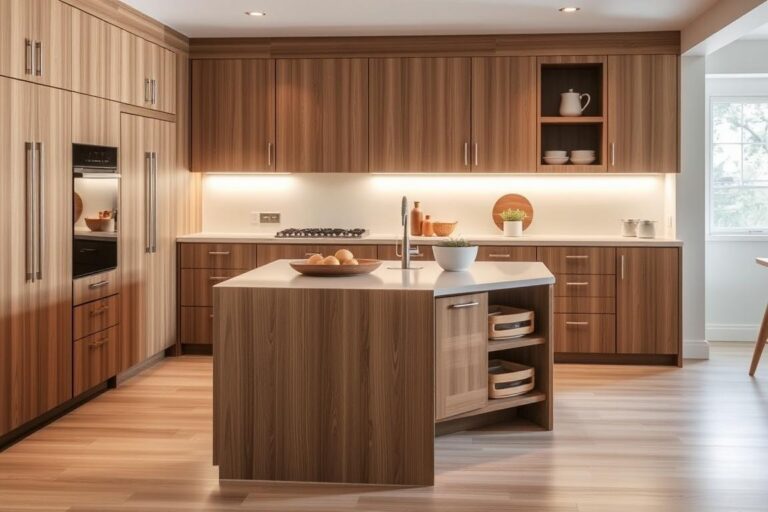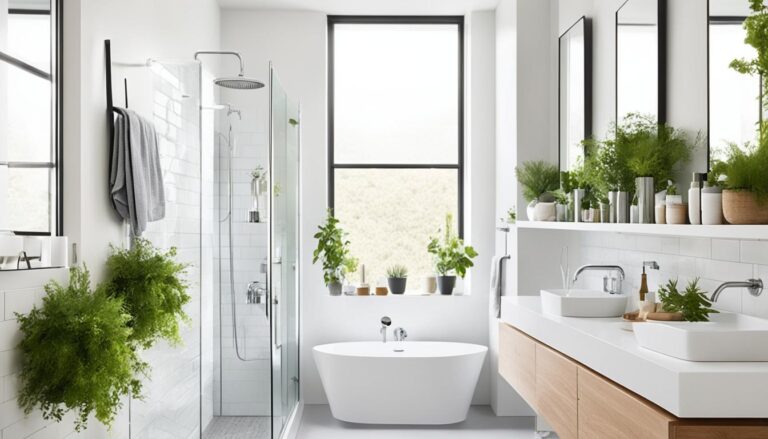We help homeowners make kitchens that are good for the planet and comfy. A smart kitchen layout can cut down on energy use. It also makes homes healthier.
When designing an energy-efficient kitchen, think about space and how you move. Most kitchen work happens in a triangle between the sink, dishwasher, and stove. A good layout makes cooking easier and saves steps.
Choosing the right appliances and using natural light helps too. This way, kitchens are not just green but also better for cooking.
We focus on making customers happy and keeping the planet safe. A great kitchen should work well, be good for the earth, and look nice. Using green materials, natural light, and efficient appliances makes a kitchen that’s just right.
Key Takeaways
- Create an energy efficient kitchen layout that promotes sustainability and reduces energy consumption
- Incorporate sustainable kitchen design principles and eco-friendly kitchen remodeling strategies
- Optimize space and workflow to streamline cooking processes and reduce movement waste
- Select energy-efficient appliances and incorporate natural light to minimize energy waste
- Choose sustainable materials and prioritize environmental responsibility in kitchen design
- Balance functionality, sustainability, and aesthetics in kitchen design
- Prioritize customer satisfaction, quality, and environmental responsibility in kitchen remodeling projects
Understanding Energy Efficiency in Kitchens
We know how important energy efficiency is in kitchens. It helps the environment and saves money. Using energy-saving appliances and green renovations can cut down on energy use and bills.
Energy-efficient kitchens have many benefits. They use less energy, save money, and are better for the planet. For example, energy-efficient appliances can use 50% less energy than regular ones. Using natural light and smart home tech can save even more energy.
Importance of Energy Efficiency
Energy efficiency is key in kitchens. It cuts down on waste and saves money. Cooking uses a lot of energy, about 35% of a restaurant’s total. By using efficient appliances and layouts, kitchens can be more eco-friendly.
Common Misconceptions
Some people think energy-efficient appliances cost more or don’t work as well. But that’s not true. These appliances work just as well but use less energy. Knowing this can help make kitchens more efficient and green.
Using energy-efficient appliances and practices helps save energy. This makes kitchens better for the planet. We’ll look at more ways to make kitchens energy-efficient next.
Key Principles of an Energy-Efficient Kitchen
We think a well-designed kitchen is key for better space use and workflow. It also helps cut down on energy use and supports the environment. Planning your kitchen space well is important for a kitchen that works well and saves energy.
Choosing the right materials is also crucial. We suggest picking materials that are good for the planet and last long. Examples include bamboo, reclaimed wood, and recycled glass countertops.
- Make a working triangle with the fridge, stove, and sink close together for better workflow.
- Pick appliances with the Energy Star logo. They use much less electricity than others.
- Use eco-friendly materials for countertops, floors, and cabinets to cut down on waste.
Following these tips helps make a kitchen that saves energy and is healthier. We aim to provide top-notch construction services. We focus on making customers happy, ensuring quality, and caring for the environment.
Layout Designs for Energy Efficiency
Creating an energy efficient kitchen layout is key. A well-designed kitchen can cut down on energy use and make cooking better. Homeowners can make a space that works well and is good for the planet.
The layout is crucial for energy efficiency. The work triangle concept helps by cutting down on moving around. Open layouts also help by letting in more natural light and air.
Energy efficient kitchen layouts offer many benefits. They use less energy, let in more natural light, and make cooking better.
- Reduced energy consumption through the use of energy-efficient appliances and lighting
- Improved ventilation and natural light, reducing the need for artificial lighting
- Enhanced cooking experience through a well-designed and functional layout
For instance, eco-friendly kitchen remodeling can include energy-saving appliances. These can use up to 30% less energy. Also, proper insulation can save 10-50% on heating and cooling costs.
By using these ideas in your kitchen design, you can make a space that saves energy and works well. We suggest looking at this table when planning your kitchen remodel:
| Layout Design | Energy Efficiency Benefits |
|---|---|
| Work Triangle Concept | Reduces energy waste by minimizing unnecessary movement |
| Open Layout | Allows for better natural light and ventilation, reducing the need for artificial lighting |
| Closed Layout | Can improve energy efficiency by reducing heat loss and gain |
Choosing an energy efficient kitchen layout and using eco-friendly remodeling can make a space that’s good for the planet and works well.
Choosing the Right Materials
Choosing the right materials for your kitchen is key. It makes your kitchen sustainable and energy-efficient. Countertops can be made from sustainable kitchen materials like recycled glass, bamboo, and quartz. These options are durable and last long.
Environmentally friendly kitchen appliances also play a big role. They cut down on energy use and reduce carbon footprint. Look for appliances with the ENERGY STAR label. This means they meet high energy standards.
- Durability and how easy they are to maintain
- How much energy they use and their environmental impact
- How they look and fit your style
- What they cost and if they fit your budget
By choosing wisely, you can make a kitchen that’s not just pretty and useful. It will also be good for the planet and save energy.
Maximizing Natural Light
Maximizing natural light is key in making an energy-efficient kitchen. Using natural light cuts down on artificial lighting. This is a big way to save energy. In a green kitchen, using energy-efficient lights is vital to lower our carbon footprint.
To get more natural light, we can use skylights, bigger windows, and reflective materials. These help bring in more light, making the kitchen feel brighter. Also, picking light colors for walls and countertops helps reflect light, making the space feel more radiant.
Here are some benefits of using more natural light in the kitchen:
- Reduces the need for artificial lighting, resulting in energy savings
- Enhances mood and energy levels, contributing to overall well-being
- Creates a brighter, more inviting space that feels larger and more welcoming
By using these strategies in our kitchen design, we make a space that’s not just beautiful but also works well and is good for the planet. With the right lights and a green kitchen makeover, we can enjoy natural light while being kind to the environment.
| Strategy | Benefits |
|---|---|
| Skylights | Increase natural light exposure, reduce energy consumption |
| Larger windows | Amplify natural light, create a brighter atmosphere |
| Reflective materials | Enhance natural light reflection, reduce the need for artificial lighting |
Efficient Lighting Solutions
We think energy efficient lighting is key in eco-friendly kitchen makeovers. The right lights help cut down energy use and make homes greener.
LED, CFL, and halogen bulbs are top choices. They use way less energy than old bulbs and last longer. For instance, LED bulbs cut energy use by up to 80% and last 15-25 times longer than old bulbs.
Types of Energy-Efficient Lighting
- LED bulbs: use up to 80% less energy than traditional incandescent bulbs
- CFL bulbs: consume less energy than traditional incandescent bulbs
- Halogen bulbs: use less energy than traditional incandescent bulbs
Layering Light in the Kitchen
To light up a kitchen well, mix task, ambient, and accent lighting. This saves energy and makes the kitchen welcoming. Adding energy-saving lights to your kitchen makeover makes it green and lovely.

Choosing smart lights and layering them in the kitchen cuts down energy use. It’s good for the planet and saves money. Plus, it makes your kitchen a cozy place to be.
| Lighting Option | Energy Consumption | Lifespan |
|---|---|---|
| LED Bulbs | Up to 80% less energy | 15-25 times longer |
| CFL Bulbs | Less energy than incandescent bulbs | 8-10 times longer |
| Halogen Bulbs | Less energy than incandescent bulbs | 2-5 times longer |
Smart Technology in the Kitchen
We think smart tech can make kitchens more energy-efficient and convenient. It helps save energy and reduces waste. By using energy-saving and eco-friendly appliances, homes become more efficient and green.
Smart tech in kitchens offers many benefits. For example:
- It cuts down energy use with smart appliances.
- It makes organizing and working in the kitchen easier with smart lighting and cabinets.
- It adds convenience with smart fridges and faucets that don’t need touching.
Studies show kitchens with smart tech use 15-25% less energy than old kitchens. Homeowners also save 10-30% on their energy bills. This depends on how efficient the appliances are.
By using smart tech, homes become greener and more efficient. This fits well with eco-friendly values. As smart home tech grows, we’ll see more ways to save energy and be eco-friendly in kitchens.
| Smart Technology Feature | Energy Efficiency Benefit |
|---|---|
| Smart Appliances | 15-25% greater energy efficiency |
| Motion-Activated Lighting | Reduced energy waste through automatic lighting control |
| Smart Cabinets | Improved organization and reduced food waste |
Water Conservation Strategies
Water conservation is key in sustainable kitchen design. Using water-saving features and materials helps reduce our environmental impact. We suggest looking into low-flow faucets and greywater recycling systems to cut down on water waste.
Effective strategies for saving water include:
- Installing low-flow fixtures and appliances to reduce water consumption
- Implementing greywater recycling systems to repurpose wastewater for non-potable applications
- Using rainwater harvesting systems to collect natural precipitation for irrigation and other uses
These steps help homeowners save water and money. They also make our kitchens more eco-friendly. By focusing on efficient space planning and sustainable materials, we can make a positive impact on our planet.
Maintaining Efficiency Over Time
We know that making your kitchen energy efficient is just the start. Keeping your kitchen green and saving energy needs regular care and updates. Eco-friendly kitchen updates help keep your space healthy and cut down on energy use.
Keeping your kitchen efficient is key. This means arranging your kitchen for better flow and less waste. Here are some tips to keep your kitchen running smoothly:
- Regularly clean your fridge’s condenser coils to make it work better.
- Keep your fridge between 35-38°F to save energy.
- Choose energy-saving appliances like LED lights and low-flow faucets.
Smart tech and energy-efficient solutions also help a lot. For example, smart thermostats adjust the temperature for you. This cuts down on energy use. Using these methods, you can make your kitchen both green and cost-effective.
Think about making your kitchen even greener with updates. Solar water heaters and induction cooktops save a lot of energy. They also help the planet. By focusing on energy efficiency and green updates, you’ll have a kitchen that’s good for you and the planet.
Evaluating Energy Performance
Keeping your kitchen energy-efficient is a continuous task. It’s important to regularly check how well your kitchen uses energy. By doing energy audits and watching your energy use, you can spot areas to get better. This helps you make smart choices to make your kitchen more eco-friendly and save money on bills.
Using smart home tech, like energy tracking systems and smart appliances, can also help. These tools give you live updates on how much energy you’re using. This lets you change your habits to use less energy. By always checking and improving your kitchen’s energy use, it will stay a green and efficient space for a long time.
FAQ
What are the key principles for creating an energy-efficient kitchen layout?
How can kitchen layout designs impact energy efficiency?
What types of sustainable materials are recommended for energy-efficient kitchens?
How can natural light improve the energy efficiency of a kitchen?
What are some energy-efficient lighting solutions for the kitchen?
How can smart technology enhance the energy efficiency of a kitchen?
What water conservation strategies can be implemented in the kitchen?
How can homeowners maintain and upgrade their energy-efficient kitchen over time?
How can homeowners evaluate the energy performance of their kitchen?
Source Links
- https://www.cooksmarts.com/articles/renovation-how-to-create-efficient-kitchen-layout/
- https://storicollection.com/blog/tips-for-achieving-an-energy-efficient-kitchen/
- https://electricaldiscountedsupplies.com/design-energy-efficient-kitchens/
- https://www.restroworks.com/glossary/energy-efficiency-in-kitchens/
- https://www.nal.usda.gov/collections/stories/step-saving-kitchens
- https://www.birkesbuilders.com/blog/all/kitchen-layout-design-principles-guide
- https://www.sustainability.vic.gov.au/energy-efficiency-and-reducing-emissions/building-or-renovating/build-for-energy-efficiency/key-principles-of-energy-efficient-design
- https://www.kitchendistributors.com/understanding-sustainable-kitchen-design
- https://homespecialistsllc.com/energy-efficient-kitchen-remodeling-tips-for-a-greener-home/
- https://sicora.com/green-kitchen-remodeling-a-comprehensive-guide/
- https://nextlevelconst.com/how-to-plan-your-kitchen-layout-for-maximum-efficiency-optimizing-space-and-workflow/
- https://casehalifax.com/how-to-choose-the-right-appliances-for-your-kitchen-layout/
- https://futuramo.com/blog/how-to-design-a-kitchen-for-maximum-functionality/
- https://www.elitekb.com/blog/how-can-i-maximize-natural-light-in-my-kitchen-design
- https://azstoneandtileconcepts.com/how-does-the-direction-of-natural-light-affect-kitchen-layouts-in-phoenix/
- https://nelsonkitchenandbath.com/2023/09/02/maximizing-natural-lighting-in-kitchen-and-bath-remodels/
- https://prestigekitchens.co.uk/kitchen-news/energy-efficient-kitchen
- https://kitchensolvers.com/energy-efficient-lighting-solutions-bright-ideas-for-a-green-kitchen/
- https://cabinet-depot.com/the-future-of-kitchens/
- https://usawire.com/revamp-your-kitchen-with-smart-technology-the-ultimate-guide-for-seattle-homes/
- https://www.leichtca.com/post/how-to-design-a-sustainable-kitchen
- https://smartwateronline.com/news/how-to-save-water-in-the-kitchen?srsltid=AfmBOopHfhTaYHcKA4qezKD4ZOFLcvvueFL7YFfS7A6jAlaAxLdaXxFR
- https://business.clickdo.co.uk/water-conservation-strategies-in-commercial-kitchens/
- https://www.greencitytimes.com/10-simple-changes-for-a-more-energy-efficient-kitchen/
- https://www.energy.gov/energysaver/kitchen-appliances
- https://creativekitchensct.com/energy-efficient-kitchen-tips-how-to-save-money-and-stay-safe/
- https://build.com.au/design-energy-efficient-kitchen/
- https://cadburykitchens.co.uk/energy-efficient-appliances-in-custom-kitchen-design/




